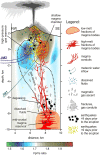Anatomy of the Bezymianny volcano merely before an explosive eruption on 20.12.2017
- PMID: 33469148
- PMCID: PMC7815830
- DOI: 10.1038/s41598-021-81498-9
Anatomy of the Bezymianny volcano merely before an explosive eruption on 20.12.2017
Abstract
Strong explosive eruptions of volcanoes throw out mixtures of gases and ash from high-pressure underground reservoirs. Investigating these subsurface reservoirs may help to forecast and characterize an eruption. In this study, we compare seismic tomography results with remote sensing and petrology data to identify deep and subaerial manifestations of pre-eruptive processes at Bezymianny volcano in Kamchatka shortly before its violent explosion on December 20, 2017. Based on camera networks we identify precursory rockfalls, and based on satellite radar data we find pre-eruptive summit inflation. Our seismic network recorded the P and S wave data from over 500 local earthquakes used to invert for a 3D seismic velocity distribution beneath Bezymianny illuminating its eruptive state days before the eruption. The derived tomography model, in conjunction with the presence of the high-temperature-stable SiO2 polymorph Tridymite in juvenile rock samples , allowed us to infer the coexistence of magma and gas reservoirs revealed as anomalies of low (1.5) and high (2.0) Vp/Vs ratios, respectively, located at depths of 2-3 km and only 2 km apart. The reservoirs both control the current eruptive activity: while the magma reservoir is responsible for episodic dome growth and lava flow emplacements, the spatially separated gas reservoir may control short but powerful explosive eruptions of Bezymianny.
Conflict of interest statement
The authors declare no competing interests.
Figures







References
-
- Pyle, D.M. Sizes of volcanic eruptions in The Encyclopedia of Volcanoes (eds. Sigurdsson, H., Houghton, B., McNutt, S., Rymer, H. & Stix, J.) 257–264 (Academic Press, 2015).
-
- Marzocchi W, Bebbington MS. Probabilistic eruption forecasting at short and long time scales. Bull. Volcanol. 2012;74(8):1777–1805. doi: 10.1007/s00445-012-0633-x. - DOI
-
- Jousset P, et al. The 2010 explosive eruption of Java's Merapi volcano—a ‘100-year’event. J. Volcanol. Geotherm. Res. 2012;241:121–135.
-
- Voight B, et al. Remarkable cyclic ground deformation monitored in real-time on Montserrat, and its use in eruption forecasting. Geophys. Res. Lett. 1998;25(18):3405–3408. doi: 10.1029/98GL01160. - DOI
-
- Sparks RSJ. Forecasting volcanic eruptions. Earth Planet. Sci. Lett. 2003;210(1–2):1–15. doi: 10.1016/S0012-821X(03)00124-9. - DOI
Grants and funding
LinkOut - more resources
Full Text Sources
Other Literature Sources
Research Materials
Miscellaneous

